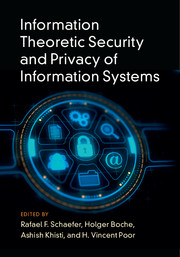Book contents
- Frontmatter
- Contents
- List of Contributors
- Preface
- Part I Theoretical Foundations
- 1 Effective Secrecy: Reliability, Confusion, and Stealth
- 2 Error-Free Perfect Secrecy Systems
- 3 Secure Source Coding
- 4 Networked Secure Source Coding
- Part II Secure Communication
- Part III Secret Key Generation and Authentication
- Part IV Data Systems and Related Applications
- Index
- References
4 - Networked Secure Source Coding
from Part I - Theoretical Foundations
Published online by Cambridge University Press: 28 June 2017
- Frontmatter
- Contents
- List of Contributors
- Preface
- Part I Theoretical Foundations
- 1 Effective Secrecy: Reliability, Confusion, and Stealth
- 2 Error-Free Perfect Secrecy Systems
- 3 Secure Source Coding
- 4 Networked Secure Source Coding
- Part II Secure Communication
- Part III Secret Key Generation and Authentication
- Part IV Data Systems and Related Applications
- Index
- References
Summary
In this chapter we consider secure source coding problems in a network scenario consisting of multiple terminals. An information theoretic formulation using a mutual information-based secrecy/privacy measure is considered. We discuss how the networking aspects such as cooperation and interaction among nodes impact the fundamental tradeoff of the secure source coding system, i.e., the tradeoff among rate, distortion, and information leakage rate. Several problem settings are presented including the setting with a helper, the setting with an intermediate node, and the setting under a reconstruction privacy constraint. Results are presented together with some comprehensive discussions.
Introduction
The concept of information security and privacy is highly relevant today, and is expected to be even more so in future networks where almost everyone and everything will be connected (cf. Internet of Things (IoT), machine to machine (M2M), etc.). Users in the network may share information with one another for possible cooperation, but at the same time they wish to reveal as little information as possible to a certain network entity. Information security and privacy have emerged as necessary features and become standard requirements in modern communication systems. From the networking perspective, they may be addressed at different layers of the system. For example, encryption is used to protect information in the link layer. Nevertheless, a major security concern lies at the physical layer where the communication channel is vulnerable to eavesdropping. Addressing these issues at the physical layer is therefore essential and can effectively complement and improve the level of security in general.
Recently, due to potential applications in areas such as privacy in sensor networks and databases (see, e.g., [1]) and privacy of distributed storage (see, e.g., [2, 3] for privacy of genomic data), the concept of information security and privacy from a data compression perspective has been studied, under a common theme called secure source coding. In this chapter, we present some interesting instances of networked secure source coding problems that take into account information theoretic security and privacy requirements in the problem formulations. Different aspects of the network involving multiple terminals will be considered, e.g., coordination with a helper, cooperation through an intermediate node, and computation based on received information.
- Type
- Chapter
- Information
- Publisher: Cambridge University PressPrint publication year: 2017



